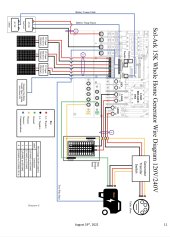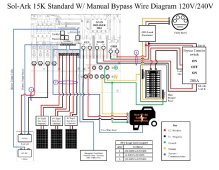Ampster
Renewable Energy Hobbyist
I would just clarify that it can also be done with $30 interlock kit, an extra breaker and some wire.I agree with @robby the installation of a transfer switch is necessary for all AIO inverters.
I would just clarify that it can also be done with $30 interlock kit, an extra breaker and some wire.I agree with @robby the installation of a transfer switch is necessary for all AIO inverters.
Maybe you should post a diagram and materials list for others. I’m sure there are other ways to do it. IMO you should have a safe method of isolating your inverter and return your loads to the grid in the event of a serious inverter malfunction or failure. Don’t think it’s necessary then don’t install one.I would just clarify that it can also be done with $30 interlock kit, an extra breaker and some wire.
A transfer switch on a hybrid inverter AC input that can immediately switch between two live asynchronous AC input sources (like grid and generator) can damage inverter.I agree with @robby the installation of a transfer switch is necessary for all AIO inverters. It allows inverter isolation for troubleshooting, service and/or replacement. Seems like a great idea so that’s what we did.
The materials list is just that, an additional breaker, some wire and the interlock kit that works with your panel. I got my inspiration after buying a switch from Midnight Solar and realized after spending many hours wiring it that it was just two interlocked breakers.Maybe you should post a diagram and materials list for others
In that scenario, my cable quick disconnect:Your inverter is making loud arcing sounds and smoke is starting to come out top of unit.
What is the first thing you are going to do (after crapping in your pants)
I have Anderson 350 connectors on my batteries, and I can testify they are not best way to pull the plug. They are not that easy to snap apart especially if you have 2/0 or 4/0 cables attached to them.
Also think about it being done in the dark.

Wouldn’t that depend on the Inverter (how it handles it)? What is your definition of “immediately?”A transfer switch on a hybrid inverter AC input that can immediately switch between two live asynchronous AC input sources (like grid and generator) can damage inverter.
Inverter's pass-through relay needs to be allowed time to disengage before subjecting AC input to an alternate, out of sync, AC source.

I think the main discussion is on a bypass transfer switch, not an input transfer switch. This one:A transfer switch on a hybrid inverter AC input that can immediately switch between two live asynchronous AC input sources (like grid and generator) can damage inverter.
Inverter's pass-through relay needs to be allowed time to disengage before subjecting AC input to an alternate, out of sync, AC source.

Post #15, by cm119 was 15 minutes before his and is likely to be the one resurrecting this post.Resurrected an old post just to take a pot shot at someone? That's classy.
The fundamental question at the beginning of this thread was whether some form of bypass was necessary. There are many options, each of which has its pros and cons.I think the main discussion is on a bypass transfer switch, not an input transfer switch.
In my installation I used this diagram to wire the bypass transfer switch along with this diagram I used for wiring the gen through an ATS.I think the main discussion is on a bypass transfer switch, not an input transfer switch. This one:
View attachment 129749
I disagree I think they are normally open grid input and require a working inverter to close the relay. It’s probably a safety issue. We know Schneider Deye and Sol Ark operate normally open.i think most of hybrids inverter transfer switch relay on the grid input is normally close, it only energize when the grid is down To isolate between inverter and grid
I disagree I think they are normally open grid input and require a working inverter to close the relay. It’s probably a safety issue. We know Schneider Deye and Sol Ark operate normally open.
I find my TOU settings are implemented immediately. I use my TOU a lot. If the time is 19:05 and I go in and put my charge to start at 1900 it starts immediately despite being past the actual 1900 start time. That’s how my Sol Ark works.I agree with you and that is how my SolArk and Skybox worked, It is normally open to the grid as a fail safe (safety reasons) if something fails the grid is not connected, That is why, when it is powered off for maintenance or firmware upgrades, I needed some form of bypass to power my critical loads panel, Sometimes I also think rebooting the inverter is a way to make sure complex programming functions get implemented, That may be the case with TOU settings where you may be making changes in a TOU time that coincides with a current timeframe.
I have seen the same thing. On my first call to tech support he had me do a full reboot after making changes and I assumed that it must be to clear some buffer or something else. It was never explained.I find my TOU settings are implemented immediately.
You have Sol Ark? I know I can make a call for battery charge in Powerview and then go into Solar Assistant and it’s charging immediatelyI have seen the same thing. On my first call to tech support he had me do a full reboot after making changes and I assumed that it must be to clear some buffer or something else. It was never explained.
Yes, I bought it in December. I can make changes in Solar Assistant also and see them instantly. Still getting used to the interface.You have Sol Ark? I know I can make a call for battery charge in Powerview and then go into Solar Assistant and it’s charging immediately
if available I would utilize TOU rates with your Utility and then take advantage of those (buy low sell high). We set our charge times based upon the daily lows and then we are able to grid sell our excess PV at the higher rates. I like Solar Assistant but for settings I use the Power View app on my phone. Just my preference.Yes, I bought it in December. I can make changes in Solar Assistant also and see them instantly. Still getting used to the interface.

Our TOU rates are hourly and change daily so we just pick the cheapest 2 hours in a day and charge cheap.Yes, those TOU settings were the first thing I focused on. The logic was different than my Skybox but I am getting used to it. I like that each rate has individual settings for charge, sell and amount. During summer my highest rate is $0.55 /kWh. and winter it is only $0.43/kWh. What I also like is the seasonal settings because my loads are greater in winter because of heating. We also have more power outages so I add a little charge from the grid early AM in case power goes out. I have discussed this more in my build thread

My SolArk 12k install with Enphase Micros
I had previously reported on my Outback Skybox install with a 7kW Enphase micro GT system.. I recently evaluated my needs and the easiest way for me to add incremental capacity is with micros on my west facing roof pitches. For a couple of reasons I decided to upgrade to a SolArk 12k which in...diysolarforum.com
I hate to get in the way of a good public hanging but could I say a few things?to complain that the SolArk didn't default to a dangerous or impossible position. Then saying the optional bypass breakers with interlock from Schneider is somehow making the Schneider better in this regard?
Don't get me wrong, I've got a Schneider XW with the bypass breakers, I see no reason I'd want to swap to a transformerless SolArk, but I've got to agree with the others. You really do seem to have an ax to grind.
As I mentioned above, I've not said one bad thing about SolArks or AIO's in this thread or at any time in the past. Could you be confusing me for someone else and/or be spring loaded to anything that you see against SolArk, imaginary or not. It appears that if anyone doesn't use "SolArk" and "perfect" in the same sentence it you take offense. Take it up with someone else, please as I might forget to follow your rules.Perhaps we should ban the mention of Sol Ark on these forums? Maybe you should approach Will about that! Your way or the highway I guess.
I am saying everyone that for an inverter to default to allowing AC passthrough would be dangerous.4- I certainly didn't say that Sol-Ark was doing anything "dangerous or impossible" and didn't even remotely imply it. Those were your words, not mine.
Seriously!? If a SolArk fails or is shut off it doesn't default to pass through the AC input to the AC output? This is certainly one of the things that really needs to be talked about more often. The Schneider XW power panels can built with a bypass kit. Of course it's limited to 60 amps but still it's super handy when you need it.
Explanation accepted but perhaps instead of blaming all of us for misunderstanding you (and there were several of us) perhaps you might want to look at the way you conveyed your message in the future. Dont you find it odd that the rest of us in here all received the same message and interpreted it the same way? Very odd indeed. The Sol Ark is not perfect but its much closer than anything else out there at the moment. Irregardless whether you have a Sol Ark or not all we expect is fair and honest. Fiction is unacceptable. Sol Ark can hold their own.I hate to get in the way of a good public hanging but could I say a few things?
1- I'm installing a Sol-Ark 15 right now. In fact, spent a few hours trying to track down a rather random arc fault error most of this afternoon.
2 - I've never said anything bad or even attempted to imply anything bad Sol-Arks or any other AIO. No SolArk et al ax today or ever in the past.
3 - I've already stated I wasn't complaining about SolArk. You can choose to believe that or not or perhaps you only read the parts of my post you wanted to. I've been guilty of that myself.
4- I certainly didn't say that Sol-Ark was doing anything "dangerous or impossible" and didn't even remotely imply it. Those were your words, not mine.
5 - Feel free to read my original post with the above in mind and maybe what you'll see is that I was expressing surprise AND admitting ignorance. My pointing out that the Schneider was limited to 60 amps was intended to illustrate a limitation compared to a 200 amp transfer switch arrangement. Did I did I actually say Schneider was better? I can't even see where it was implied.
As I mentioned above, I've not said one bad thing about SolArks or AIO's in this thread or at any time in the past. Could you be confusing me for someone else and/or be spring loaded to anything that you see against SolArk, imaginary or not. It appears that if anyone doesn't use "SolArk" and "perfect" in the same sentence it you take offense. Take it up with someone else, please as I might forget to follow your rules.
What I was trying to say is that I was ignorant about the benefits of using a transfer switch with a SolArk and trying to point out that others could be helped, particularly during the planning stages if they knew this information. Transfer switches have always been my practice, but the AIO is new to me. The irony is that is I was so impressed with everything else I'd heard about Sol-Ark it seemed odd that their "failure mode" didn't result in the AC In being fed to the AC Out.
Months later you take a shot at me out of the blue for something you thought I said, and I responded accordingly not realizing that you thought I was the chief architect and prosecutor Sol-Ark and all AIO's.
Feel free to proceed with the public hanging, just try to supply evidence before you make any more accusations.
Cheers!
I agree. I have used the Midnite Solar MNTRANSFER-60A, so you can connect either the GRID or the LOAD to the LOAD, but not both at the same time. The other breaker turns off before the 2nd breaker turns on. The largest breakers I have found for the enclosure are 80 Amps. I have looked for a larger amperage unit of this design, but have not been able to find one. They are all just DPDT.A transfer switch on a hybrid inverter AC input that can immediately switch between two live asynchronous AC input sources (like grid and generator) can damage inverter.
Inverter's pass-through relay needs to be allowed time to disengage before subjecting AC input to an alternate, out of sync, AC source.


